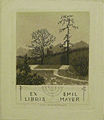James Bieberkraut
James Bieberkraut (born April 16, 1879 in Leipzig , † 1975 in Jerusalem ) was a German - Turkish painter , etcher , restorer and scientist .
Life
Parents were Salomon Bieberkraut and Pepi Bieberkraut (née Haimann). The father was a master tailor in Leipzig. James Bieberkraut was a Turkish national.
After his first years of study in Leipzig, he moved to Berlin to attend the art academy there (Boese class). On November 2, 1898, he began his lessons at the Academy of Fine Arts in Munich under Nikolaus Gysis . He remained a student there for four years, namely until 1902. Several stays abroad followed, especially in Italy. On April 16, 1928, James Bieberkraut married the then 32-year-old art photographer Helena Joseph. The marriage took place in front of the registry office in Rothenburg. Until 1934 James Bieberkraut was demonstrably resident in Munich and worked as a painter and etcher. Bieberkraut announced a total of 4 residences to the Munich city council; including Neureutherstrasse 18, and most recently Linprunstrasse 69. He then traveled to Palestine .
The artist's works are predominantly landscapes and portraits. He also worked as a commissioned artist and created several bookplates, among other things .
In a second phase of life (in Jerusalem), Bieberkraut was very busy restoring old documents. In the 1940s and 1950s, he played a key role in the restoration and opening of the so-called "Dead Sea Scrolls" . For this he gained worldwide recognition.
According to a contemporary witness, Siegfried Rickler, James Bieberkraut and his wife visited Germany for a quarter of a year around 1967 and lived with Betty and Karl Brenner in Munich. According to the contemporary witness, James Bieberkraut visited Munich again at the age of 90.
According to the contemporary witness, James Bieberkraut was a professor in Jerusalem. He was a professor of chemistry at Hebrew University, according to a source, he was not a professor.
Bieberkraut created several large-format etchings with views of the city of Jerusalem as a motif.
His autodidactic knowledge in the field of chemistry, especially for the aquatint etchings, was very useful for his scientific activities.
In 2010, the Innbuecher antiquarian bookshop, located near Munich, started to rediscover the work of Bieberkraut. Several projects are planned, including an exhibition in Munich and a catalog raisonné.
Works (selection)
-
Oil paintings
- The winter
- Still life with cancer, 74 × 90 cm
- The morning
- Portrait of the father
- Portrait of a girl
- Winter landscape, 1914, 83 × 134 cm
- Human tragedy, 1919
- Snowy, 1919
-
Etchings
- Child at the Mirror, 1904
- Evening mood at the Lachersee, 1912, 41.5 × 31 cm, aquatint
- Evening glow, 1919, colored etching
- In the stable, 23.4 × 29 cm
- A winter symphony (Opus 47a – f): portfolio with 6 etchings, 1927, 100 numbered copies with additional single sheets (101–300). The individual sheets are called: Introduction (Benediktenwand), Romance (Graseck), Sonata (Leutaschtal), Elegy (Reiterspitze), Nocaturno (Oberleutasch) and Cantata (Raintal)
- Cypress trees
- capri
- Ships (in Holland)
- Bavarian farmstead
- Cold winter day
- Winter in the mountains
-
Bookplate
- for Else Kirschner, 6 × 9 cm
- for a hunter
- for Mr. and Mrs. Steinhäuser (several variants)
- for Emil Mayer
-
Advertising graphics: posters, advertising stamps, postcards
- Advertising stamp for a Swiss watch manufacturer, 4.2 × 5.7 cm, lithograph, before 1934
- Posters for various companies in Switzerland, lithograph, before 1934
Exhibitions
- 1905: Osnabrück Museum, Dürerbund
- 1906: Kunstverein Hamburg
- 1908: International art exhibition in Munich
- 1915: Osnabrück Municipal Museum, Dürerbund
- 1918: Art exhibition in Baden-Baden
- 1919: Glass Palace Munich
- 1927: Ewer-Buchhandlung Munich, exhibition of a new portfolio with 6 etchings (a winter symphony)
- 1928: Galerie Paulus Munich, exhibition of his etchings
Cross-section through the artist's work
Literature (selection)
- Adolf Schaalmann: James Bieberkraut, the painter and etcher. In: Bayerische Israelitische Gemeindezeitung Volume 3, Issue 2, February 9, 1927, pp. 32–35 ( digitized version )
- Bieberkraut, James . In: Hans Vollmer (Hrsg.): General Lexicon of Fine Artists of the XX. Century. tape 1 : A-D . EA Seemann, Leipzig 1953, p. 207 .
- Max Kirschner: There is a time for crying and a time for laughing: memories from two worlds. Jüdischer Verlag im Suhrkamp Verlag, Frankfurt am Main 2004, ISBN 3-633-54213-2 , p. 35
- Hans Lamm : From Jews in Munich. Ner-Tamid-Verlag, Munich 1958, p. 235
- Hans Lamm: Bygone days: Jewish culture in Munich. Langen Müller, Munich and Vienna 1982, ISBN 3-7844-1867-8
- Karl Emich Graf zu Leiningen-Westerburg: German and Austrian library symbols, bookplates. Julius Hoffmann, Stuttgart 1901; Reprint: Zentralantiquariat der DDR, Leipzig 1980
- Ex libris: book art and applied graphics. Volume 17
- Bieberkraut, Jakob. In: Hermann Alexander Müller , Hans Wolfgang Singer : General Artist Lexicon. 6th edition, Volume 6, Literary Institute Rütten & Loening, Frankfurt am Main 1922, p. 25
- Volker Frank: Bieberfeld, James . In: General Artist Lexicon . The visual artists of all times and peoples (AKL). Volume 10, Saur, Munich a. a. 1994, ISBN 3-598-22750-7 , p. 524.
Individual evidence
- ↑ a b Nadav Mann: He didn't even know that he was one of them: Prof. Bieberkraut (in Hebrew ), in Ynet
- ↑ Matriculation entry
- ↑ Ernst Krüger: Isn't the Bible right? In: The time. February 23, 1956.
- ↑ http://www.nytimes.com/1991/09/29/weekinreview/ideas-trends-lessons-learned-from-unscrolling-two-religions-turbulent-pasts.html
| personal data | |
|---|---|
| SURNAME | Bieberkraut, James |
| BRIEF DESCRIPTION | German-Turkish painter, etcher, restorer and scientist |
| DATE OF BIRTH | April 16, 1879 |
| PLACE OF BIRTH | Leipzig |
| DATE OF DEATH | 1975 |
| Place of death | Jerusalem |




